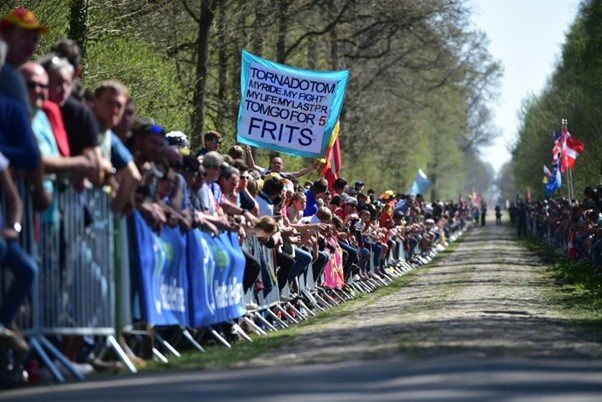Race Guide to the Hell of the North: Paris-Roubaix
By Tim Perkin
When the flag drops to mark the start of Paris-Roubaix race on Sunday 7th April, it will be the 121st time this race has been run. It is one of the most historical races in cycling and was first held in 1896 and takes place in northern France. Due to its difficulty, a consequence of often severe weather conditions, a long and difficult course, it has earned the nickname the “Hell of the North.”
The 260km long route is particularly challenging due sections of the course being made up of small granite stones called cobblestones, or “cobbles” as they are referred to. The 2024 race will include 55.7km of cobblestone sections, an increase from 2023, which had 54km’s.
History
Theodore Vienne and Maurice Perez, two textile manufacturers from Roubaix, are credited as founders of the Paris-Roubaix race. They had previously constructed a velodrome in 1895 and in efforts to promote it organised the road race. The first event was hosted in 1896 and was won by German, Josef Fischer, while the roads they raced were comprised of cobblestones.
Belgians have dominated the race. Belgian legend Eddy Merckx won it three times. Fellow countrymen Tom Boonen and Roger de Vlaeminck held the record for the most wins, each with four victories.
Paris-Roubaix has long been considered as the “Queen of the Classics” and it was the race where the term “Monument” was first used in 1949 by French sports journalist Albert Baker d’Isy. This term is now widely used to describe some of the major one-day races.
Since 1977, the winners of the race receive an individual cobblestone, mounted on a plinth. In addition, the winner is honoured with a plaque bearing their name, placed in the historical communal showers, located near the entrance to the velodrome.
Paris–Roubaix Femmes
With the addition of the Paris-Roubaix Femmes race in 2021, a new chapter in the event’s history was written. The winner of the first edition of Paris–Roubaix Femmes was Lizzie Deignan, racing for Trek-Segafredo.
Route
Over the history of the race, the length of the course has varied. Early editions such as 1896 and 1897 were 280km long. Recent races have been on average 260km long, including the 2024 edition, which measures 259.9km.
The route originally started in Paris, but in 1966 the start was moved to Chantilly and later to Compiègne, in 1977.
Honouring the history of the race on cobblestone roads, this year, the riders will face 29 sections of cobblestones during the race. The first section comes after 96.3km and vary in length and difficulty, graded on a scale of 1 to 5 stars, with 5 stars indicating the highest level of difficulty.
There are three sectors in total that have a difficulty rating of 5 stars. One of the most famous sectors is the Trouée d’Arenberg and has a difficulty rating of 5 stars. The other two are Mons-en-Pévèle and Carrefour de l’Arb. There is also a particular long sector #26, Viesly to Briastre, which spans a distance of 3km.

Trouée d’Arenberg (Photo credit: Paris-Roubaix /Pauline Ballet)
The iconic finish features riders entering the velodrome in Roubaix and completing one and a half laps of the track before finishing. This finish format was first used in 1943 and it has been the customary end to the race, except for the years 1986-88.
Paris-Roubaix Femmes will be raced on a slightly modified route to the men’s and will total 148.5km, out of which, 29.2km will be raced over the cobbles and will be divided into 17 sectors. Like the men’s race, women’s race will also finish in the iconic velodrome.
Race moments to remember
The race has seen many unforgettable moments. In 2006, Discovery Team’s George Hincapie had the t most unfortunate accident. At 45 kilometres from the finish and in the leading group, the steering tube on his bike snapped, resulting in George riding for a split second with his handlebars disconnected from the bike. This ended in an unfortunate crash.
In 2015, the race was temporarily halted as riders were caught behind railway safety barriers and were forced to wait and watch as France’s fast train, the TGV, hurtled past. Some riders decided to circumvent the barriers, which resulted in a rule change for the event, the following year.
The first edition of the Paris-Roubaix Femmes saw Lizzie Deignan launch a breakaway, 82.5km from the finish and rode solo over the cobbles, to victory. An inspiring ride to witness.
This certainly is the race where you can expect the unexpected.
Riders to watch
In the men’s race, there will be two teams to watch, and they will be expecting victory. They are Team Visma–Lease a Bike and Alpecin–Deceuninck. In the women’s race, Marianne Vos will be wanting to add another Paris-Roubaix Femmes title to list of achievements.
Team Visma–Lease a Bike boasts a formidable team with Dylan van Baarle hoping to repeat his 2022 victory. Each team can field a maximum of 7 riders.
Out to stop Team Visma–Lease a Bike’s earlier season domination will be the duo from Alpecin–Deceuninck, 2023 winner, Mathieu van der Poel and recent Milan–San Remo winner, Jasper Philipsen.
Summing Up
Both races will be a test of skill and endurance that is steeped in history, but in a race where the unexpected is just around the corner, luck as much as skills will play a significant part in the outcome. This event is always a spectacle and rightly deserves the nickname of the “Hell of the North.”
—
About the Author
Tim has a passion for cycling and it was integral to regaining fitness after an arduous battle with cancer. Tim is the founder of Mountain Massif, who host esports cycling events. Over the years, Tim has written about a range of cycling topics, including testing and reviewing the major smart trainers. In addition, he has been fortunate to ride and interview some of the sports leading figures such as Tour de France winner Andy Schleck and sprint legend André Greipel.

